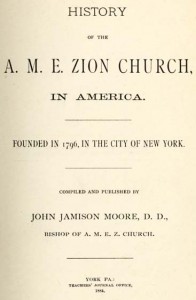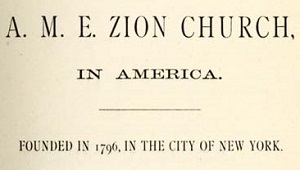African American History, Ask A Librarian, California History, Napa
Ask A Librarian: AMEZ in Napa
If we had a “colored school” in Napa, did we also have an African Methodist Episcopal Zion Church?
 Churches were the first Black organizations to develop in Northern California, and the first Black church founded in the state was likely the African Methodist Episcopal Church (AME) in Sacramento.[i] AME had its origins in eighteenth century east coast white church goers refusing Black congregants, so it is more than a little ironic that California’s AME churches were established under willing and eager segregation.[ii] AME has traditionally always been a politically and socially active church, focusing on education, political involvement, and community engagement. Whether Christianity, Islam, Judaism, or some other faith, religion remains a key facet of life for many African Americans, and for many the church continues to serve as a center of community.
Churches were the first Black organizations to develop in Northern California, and the first Black church founded in the state was likely the African Methodist Episcopal Church (AME) in Sacramento.[i] AME had its origins in eighteenth century east coast white church goers refusing Black congregants, so it is more than a little ironic that California’s AME churches were established under willing and eager segregation.[ii] AME has traditionally always been a politically and socially active church, focusing on education, political involvement, and community engagement. Whether Christianity, Islam, Judaism, or some other faith, religion remains a key facet of life for many African Americans, and for many the church continues to serve as a center of community.
In Napa, Black Methodists attended alongside their white fellow congregants, but in 1867 they collected funds to establish their own AME Zion (AMEZ) church. A solicitation note in the Napa Daily Register read:
Our colored people are passing around a subscription paper, or, rather, collecting money to pay for the church they lately purchased from the M. E. congregation in Napa. We hope they will be successful in their efforts. Our citizens generally, should contribute to this enterprise. Give what you can, and let the colored people have a house of worship of their own. As a people they have never before made an appeal to our citizens, and have always given their mite towards celebrations and paying church debts. We should return their favors.[iii]
Apparently they were successful in their request, for they relocated the Methodist church’s old wooden structure to a site near Washington Street in Napa. The segregation of churchgoers seems to have had less to do with racial tensions and everything to do with wanting a church to call their own. Bishop J. J. Clinton gave two speeches at the two Methodist churches in 1868, and attracted such attendance that many people attended both engagements – the white church was full of Black congregants for the morning service, and the tiny AMEZ church was packed with white attendees in the evening.[iv]
Despite having a population who claimed to be “religious and strictly moral” and deserving of “all commendation for industry, sobriety, intelligence and moral worth,” attendance faltered at the Black church.[v] They were also unable to secure a permanent minister, although Reverend Robert Rice, Aaron’s father, frequently officiated.[vi] They may have been unable to pay for a college-trained rector out of their local tithes and dissatisfied with the less qualified options. Many Black preachers lacked formal theological training and were, “in the words of Darius Stokes, ‘all sound and no sense, depending upon stentorian lungs, and a long-drawn mourn, for their success.’ Under such pastors, church services tended to become intensely emotional, with trances and weird singing.”[vii]
What Napa’s African Americans needed was a community leader and organizer, not a showman, but with such a small congregation and so few with salaries large enough to support constant funding, the congregation floundered. By 1881, the church was “the abode of bats and mice, being entirely dilapidated.”[viii] According to the oral tradition of Kyle’s Temple AMEZ church in Vallejo its first congregation in the late nineteenth century was comprised of some of Napa’s AMEZ members. So far, no evidence has turned up to either prove or disprove that theory, but it is possible given the Black flight out of Napa and into Vallejo in the years before Kyle’s Temple was founded.
[Ed. note: this article is excerpted in part from the master’s thesis “There Are No Black People in Napa”: A History of African Americans in Napa County by Alexandria Brown.]
[i] Rudolph M. Lapp, Blacks in Gold Rush California (New Haven, CT: Yale University Press, 1977): 6.
[ii] Edward L. Queen, “African Methodist Episcopal Church (AME),” Encyclopedia of American Religious History, Third ed. (New York: Facts On File, 2009), http://online.infobase.com/Article/Details/197415?q=ame church.
[iii] “Methodist Church,” Napa Daily Register, May 11, 1867, microfilm.
[iv] Joseph S. Hatton, letter to the editor, Elevator (San Francisco), January 24, 1868, http://cdnc.ucr.edu/cgi-bin/cdnc?a=d&d=EL18680124.2.10&srpos=24&e=–1860—1900–en–20-EL%2cPA-21–txt-txIN-colored+citizens+napa——#.
[v] “Mr. Moore’s Visit to Napa,” Elevator (San Francisco), October 6, 1865, http://cdnc.ucr.edu/cgi-bin/cdnc?a=d&d=EL18651006&e=——-en–20–1–txt-txIN——-.
[vi] Philip A. Bell, “Napa City,” Elevator (San Francisco), November 1, 1873, http://cdnc.ucr.edu/cgi-bin/cdnc?a=d&d=EL18731101.2.8&srpos=17&e=——-en–20-EL-1–txt-txIN-sparrow——#.
[vii] B. Gordon Wheeler, Black California: The History of African-Americans in the Golden State (New York: Hippocrene Books, 1993): 134.
[viii] Slocum, Bowen & Co., pub., History of Napa and Lake Counties, California, (San Francisco, Slocum, Bowen & Co., 1881): 265.


